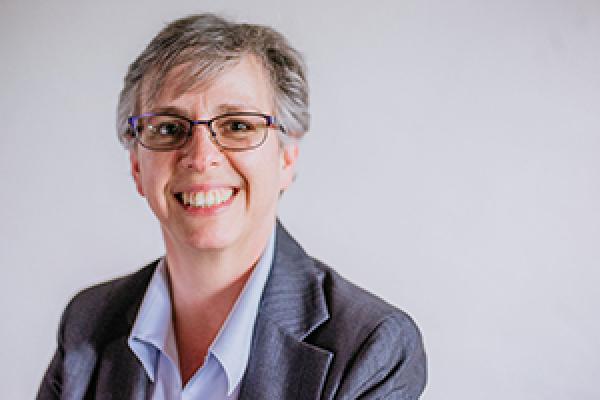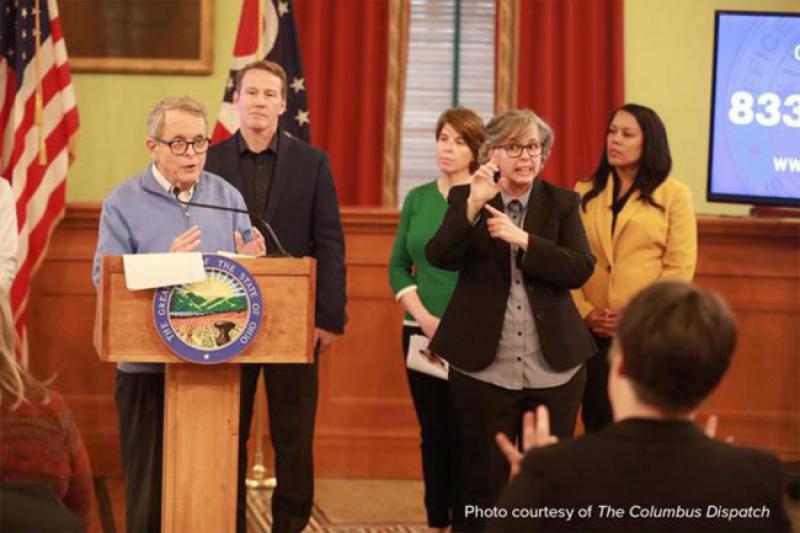Berkowitz raises profile of interpreters at coronavirus briefings


As the only certified deaf interpreter in Ohio, Marla Berkowitz is typically called to interpret for critical settings such as court arraignments, therapy sessions and educational trainings.
Her latest assignment is no exception. She is part of a team of ASL interpreters at Gov. Mike DeWine’s daily briefings on the coronavirus crisis.
“The responsibility is enormous when it comes to interpreting for the public, especially during crisis times,” Berkowitz, a senior lecturer in Ohio State’s ASL program, said via email. “Deaf people who use ASL deserve to have first-hand information at the same time as their hearing counterparts about their health and safety. For me, the ASL interpreting profession is sacred.”
During DeWine’s COVID-19 briefings, Berkowitz, who is deaf, captures the information from a hearing ASL interpreter, then interprets it to make it more understandable to the Deaf community members.
Hearing ASL interpreters tend to sign in literal terms, which can get lost among the Deaf community, said Tia Jones, program manager of Ohio State’s ASL program.
Berkowitz makes the language more accessible, especially for those who can’t read the captions or have low English skills. She signs using the regional dialect and breaks down concepts that employ ASL grammar versus an English one.
“Sometimes, hearing interpreters can’t break down the language to that level,” Jones said.
For example, facial expressions are important in conveying the nuance of a message. When interpreting “stay home,” Berkowitz said she emphasizes it with a stern face as an urgent plea to take action. Facial expressions also help the Deaf community understand whether the speaker is asking a question or making a statement, she said.
Typically, ASL interpreters are hearing people and second-language learners, Berkowitz said.
“The Deaf audience culturally can relate more to certified deaf interpreters,” she said.
Berkowitz was drawn to interpreting in the early ’70s when she was 7 at a residential school for the deaf in New York, where she is from. She had teachers who were not fluent in ASL, and her classmates would turn to her to explain or clarify the teachers’ message. In the ’80s, she worked at a nonprofit that provided services for Deaf, Deaf and Blind, Deaf and Disabled and those who were hard of hearing, where she was often asked by clients and hearing staff to clarify, explain or interpret letters from social security, health insurance companies and utility agencies.
She was called to do more interpreting work when she was asked to lip-read for a man who couldn’t use his voice while communicating to his family in the hospital. That led to other interpreting work, including the courts system in New York.
While there are other deaf interpreters in Ohio, Berkowitz is the only one certified by the Registry of Interpreters for the Deaf and the Supreme Court of Ohio. The Opportunities for Ohioans with Disabilities, a state agency that provides financial and educational support for those with physical and mental disabilities, requested her for DeWine’s daily briefings.
In addition to her interpreting duties, Berkowitz teaches two sections of American Sign Language 1101 and co-teaches The Intersections of American Sign Language, Deaf Culture, and the Deaf Community service learning course with Kristin Wickham-Saxon.
Hannah Portmann, a speech and hearing science major, has been watching her former instructor with pride. She took Berkowitz’s American Sign Language Deaf Arts and Literature and ASL service learning courses as a sophomore and junior. Through Berkowitz, she has gotten a better understanding of cultural norms surrounding the Deaf community and aspires to be an advocate for them.
“She is very engaging, and she likes to add a lot of her own passion and personal touch,” said Portmann, who graduate this spring and will be attending graduate school for speech therapy in the fall. “She clearly cares a lot about what she is giving in terms of information.”
Berkowitz’s demonstrative facial expressions and her sharp gestures have garnered fanfare from Ohioans tuning into the televised press conferences, including a Facebook fan page and several Twitter memes. Berkowitz appreciates the attention and hopes her work offers a sense of calm amid a time of uncertainty and helps people feel less scared about what they need to know to protect themselves.
“If that’s what it takes, I can sleep at night knowing I have made a difference,” she said.
